Understanding sound is crucial in general science and essential for most competitive exams. This post covers one of the most important topics from the “Sound” chapter of the NCERT class 9 Physics textbook: Different Characteristics of Sound.
We’ll cover the core and additional characteristics of sound in detail, along with key points and infographics to enhance your understanding.
What is Sound?
A sound is a form of energy that travels through a medium (like air, water, or solids) as a wave.
Vibrations create this wave, and when these vibrations reach our ears, our brain interprets them as sound.
So, to hear a sound, we need something to vibrate (the source), a medium for the vibrations to travel through, and our ears to detect those vibrations.
Sound’s primary characteristic is its nature as a longitudinal wave, which requires an elastic medium for propagation. Due to this requirement, sound cannot travel through a vacuum.
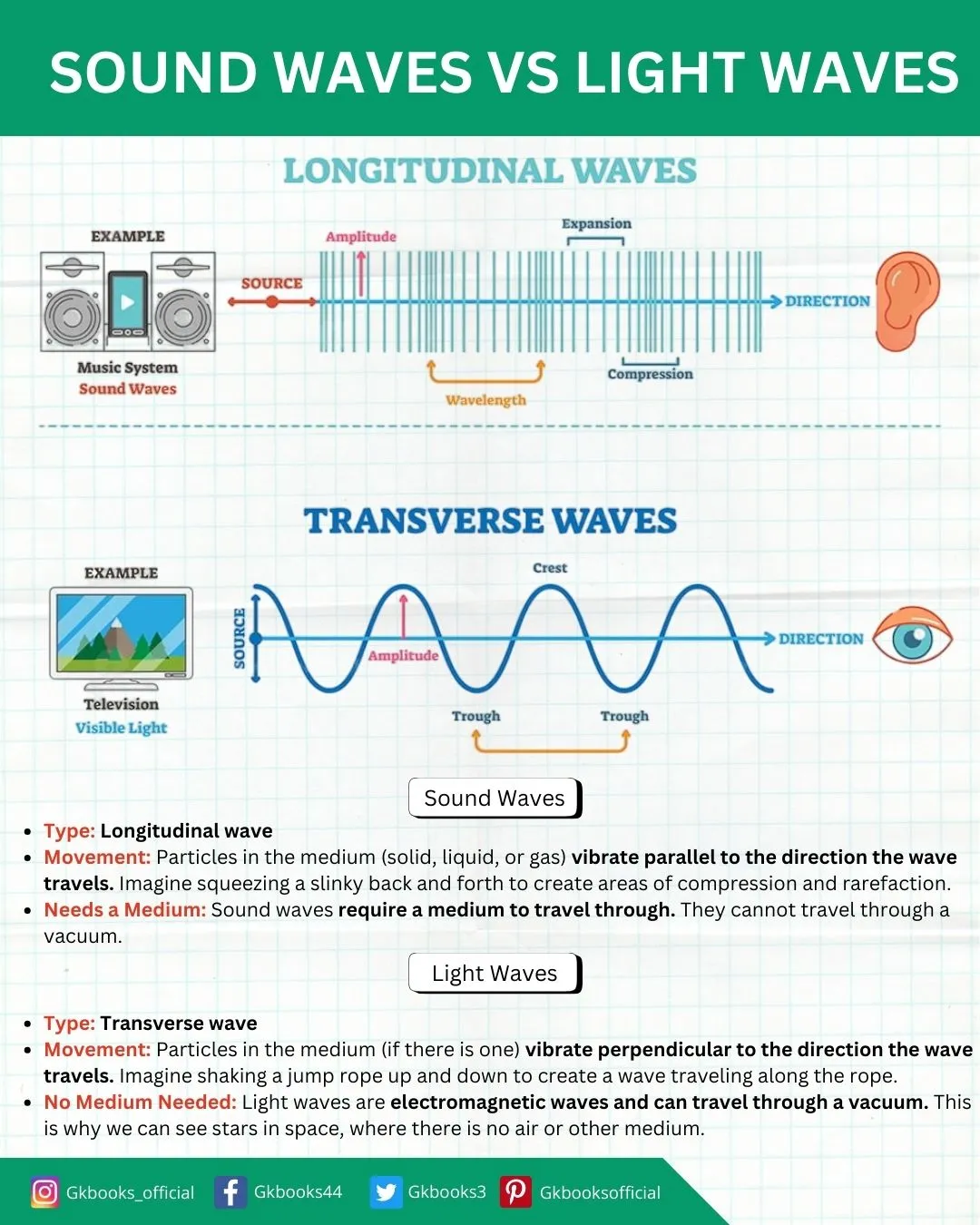
Importance of understanding sound characteristics
Understanding sound characteristics is essential for various reasons, impacting fields from music and engineering to everyday life. Here’s a breakdown of its significance:
Enhanced Appreciation of Sound
- Richer Experience of Music: By understanding how frequency relates to pitch and amplitude to loudness, we can appreciate the nuances of music. We can differentiate between a flute’s high-pitched notes and a cello’s deep bass.
- Discerning Different Sounds: Timbre, which depends on the sound’s harmonics, allows us to distinguish between instruments or voices. It’s why a piano and a violin playing the same note sound completely different.
Applications in Various Fields
- Acoustics: Understanding how sound travels through different mediums helps design concert halls, cinemas, and recording studios for optimal sound quality.
- Audio Engineering: From mastering a song to designing noise-cancelling headphones, engineers rely on their knowledge of sound characteristics to manipulate and control sound.
- Physics and Beyond: Studying sound waves is fundamental to physics, with applications in areas like seismology (studying earthquakes) and medical imaging (ultrasound).
Everyday Benefits
- Understanding Our Environment: Sound characteristics tell us a lot about our surroundings. A car’s honking horn warns us of danger, while birds chirping signal a peaceful environment.
- Improved Communication: By controlling the volume and clarity of our speech, we can ensure effective communication and avoid misunderstandings.
In conclusion, understanding sound characteristics goes beyond simply hearing. It unlocks a deeper appreciation for the world around us and empowers us to create, manipulate, and interpret sound meaningfully.

✅ Total Internal Reflection, Definition, Conditions, Application
Core Characteristics of Sound Waves
Sound waves are a fascinating phenomenon that allows us to perceive the world. They are invisible disturbances that travel through a medium, carrying energy from one place to another.
These waves are characterized by several fundamental properties that determine how we experience sound. Let’s discuss the three main characteristics of sound waves: frequency, amplitude, and wavelength. Each plays a crucial role in shaping the way we perceive sound.
Frequency
Frequency is a core characteristic of sound waves and directly relates to how we perceive pitch. Here’s a breakdown:
Imagine a sound wave
Picture a wave travelling through the air, like ripples on a pond. Similar to those ripples, sound waves have highs and lows. These highs and lows correspond to areas of compressed and less-compressed air molecules.
Frequency and Vibrations
The frequency of a sound wave refers to how often these compressions and rarefactions (highs and lows) cycle by a point in one second. It’s the number of times the air vibrates back and forth per second. This frequency is measured in Hertz (Hz).
Frequency and Pitch
Here’s the exciting part: our brains interpret this frequency as pitch. A high frequency, with many vibrations per second, translates to a high-pitched sound, like a whistle or a squeaky toy. Conversely, a low frequency, with fewer vibrations per second, is perceived as a low-pitched sound, like a drumbeat or a deep voice.
Analogy
Think of it like a jump rope. If you swing the rope fast (high frequency), you get rapid, small jumps, similar to a high-pitched sound with many vibrations. If you swing the rope slowly (low frequency), you get larger, slower jumps, identical to a low-pitched sound with fewer vibrations.
So, by understanding the frequency of a sound wave, we can predict how high or low it will sound to our ears.
✅ Different types of work done, Definition, Units, and Dimension
Amplitude: The Loudness of the Sound
In the context of sound waves, amplitude refers to the height or maximum displacement of the wave from its resting position. It’s like the difference between a quiet pond ripple and a crashing ocean wave. Imagine sound waves as variations in pressure caused by vibrations.
Here’s how amplitude relates to loudness:
Larger Amplitude
The pressure variations are more significant when the sound wave has a larger amplitude. This translates to the particles in the medium (air, water, etc.) being displaced further from their regular positions. Our ears interpret these more significant pressure fluctuations as a louder sound.
Smaller Amplitude
Conversely, a sound wave with a smaller amplitude means the pressure variations are less pronounced. The particles in the medium move a shorter distance back and forth, resulting in a softer sound our ears perceive.
Analogy
Think of amplitude like the volume knob on a music system. Turning the knob up increases the amplitude of the sound wave, resulting in louder music. Conversely, turning it down reduces the amplitude, making the music softer.
Amplitude is not directly measured in units like meters (m) or centimetres (cm). Instead, relative values or pressure units often represent it depending on the context.
Unit of Loudness
Loudness is a subjective perception of sound intensity, which varies depending on an individual’s hearing ability and sensitivity. To address this subjectivity, scientists have developed several units to quantify loudness:
Phon (ph)
This unit directly relates to human perception of loudness. By definition, 1 phon is equal to the loudness of a 1000 Hz (1 kHz) pure tone perceived as barely audible by an average young person.
Sone
This is another unit based on human perception but on a loudness scale. One sone is defined as the loudness equal to 40 phons. This means sounds perceived as twice as loud would be rated as 2 sone.
Decibel (dB)
This is a unit of sound pressure level that is not directly related to loudness perception. However, it’s a widely used unit based on a logarithmic scale, which reflects how the human ear perceives changes in sound intensity. A 10 dB increase in sound pressure level is generally perceived as a doubling of loudness.
✅ Points to Remember
🔹Phons and sones are more directly tied to human perception of loudness, while decibels measure sound pressure level.
🔹Decibels are often used with a reference level to specify loudness. For example, 0 dB refers to the hearing threshold and sounds above 120 dB can be considered uncomfortable or painful.
🔹Intensity: As you mentioned, sound intensity is the objective measure of sound energy per unit area. While not directly representing loudness, it is a physical property that can be used to calculate loudness based on models that account for human hearing.
✅ Loudness Exam-oriented Key Points
🔸 Loudness is an auditory sensation in which our ear can precept a sound. 🔸It is a subjective Quantity.
🔸 The Loudness or softness of a sound depends on the Amplitude of that sound wave.
🔸The Loudness is directly proportional to the square of the Amplitude of the sound wave.
🔸The Loudness of a sound wave is Inversely proportional to the square of the distance between the sources.
🔸 Loudness also depends on the density of the medium; more density means more Loudness.
🔸 Also, it depends on the Surface area of the vibrating body; more surface area produces more Loudness.
🔸Amplitude refers to the maximum displacement or distance moved by a point on a vibrating body or wave from its equilibrium position, representing the magnitude of the wave’s disturbance in the medium.
🔸 It is usually represented by the letter ‘A’.
🔸Compared to soft sound, a Louder sound can travel a distance because a louder sound has higher energy.
Intensity
The amount of sound energy passing per unit of time through a unit area is called the Intensity of sound. The area is perpendicular to the direction in which the sound waves propagate.
The SI unit of intensity – watt / m2.
The intensity of sound is an objective quantity as it can be defined with a numerical value, such as 5 watts per square meter (W/m²). This value remains consistent across individuals, making it a standardized measure of sound energy.
In Physics the intensity of the zero-decibel sound is considered the weakest intensity which is 10-12 watts / m2. [10-12 joules of energy passed through a unit area]
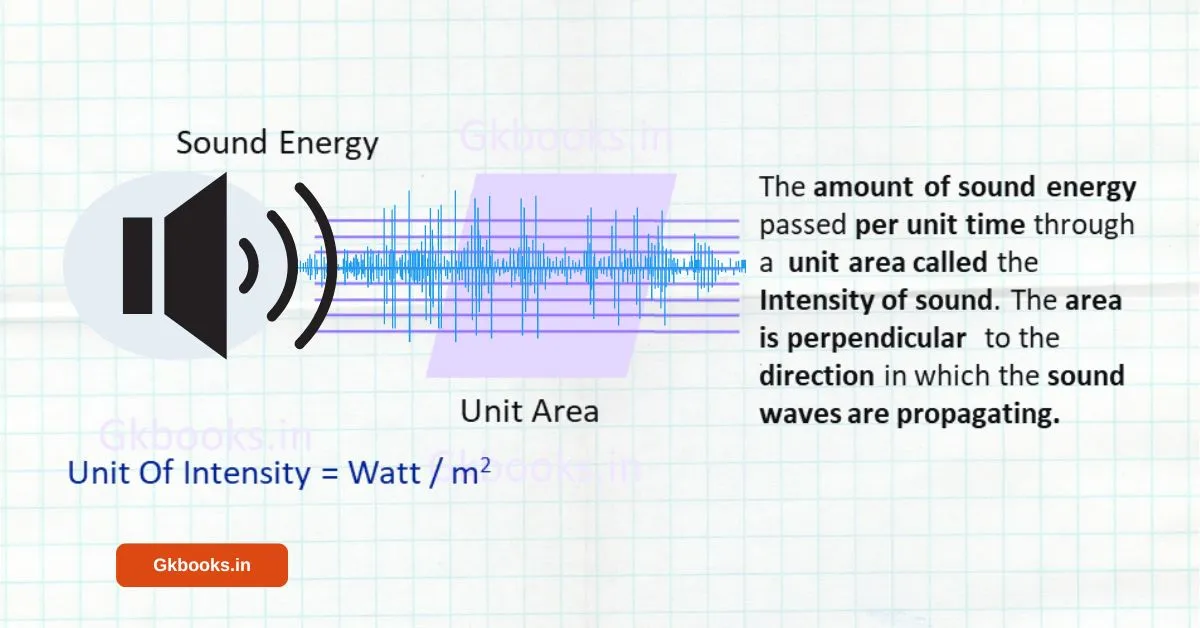
Wavelength: Unveiling the Pitch
Wavelength, another characteristic of sound waves, refers to the distance between two consecutive identical points on the wave. Imagine a wavy line representing a sound wave. Wavelength is the distance between two successive peaks (crests) or two straight troughs of that wave.
Here’s the exciting connection between wavelength and pitch:
Longer Wavelength
When a sound wave has a longer wavelength, the distance between peaks or troughs is greater. This translates to slower vibrations in the medium. Our ears perceive these slower vibrations as lower-pitched sounds, often described as more profound or bassier.
Shorter Wavelength
Conversely, a sound wave with a shorter wavelength has shorter distances between peaks or troughs. This translates to faster vibrations in the medium. Our ears interpret these faster vibrations as higher-pitched sounds, often described as shriller or thinner.
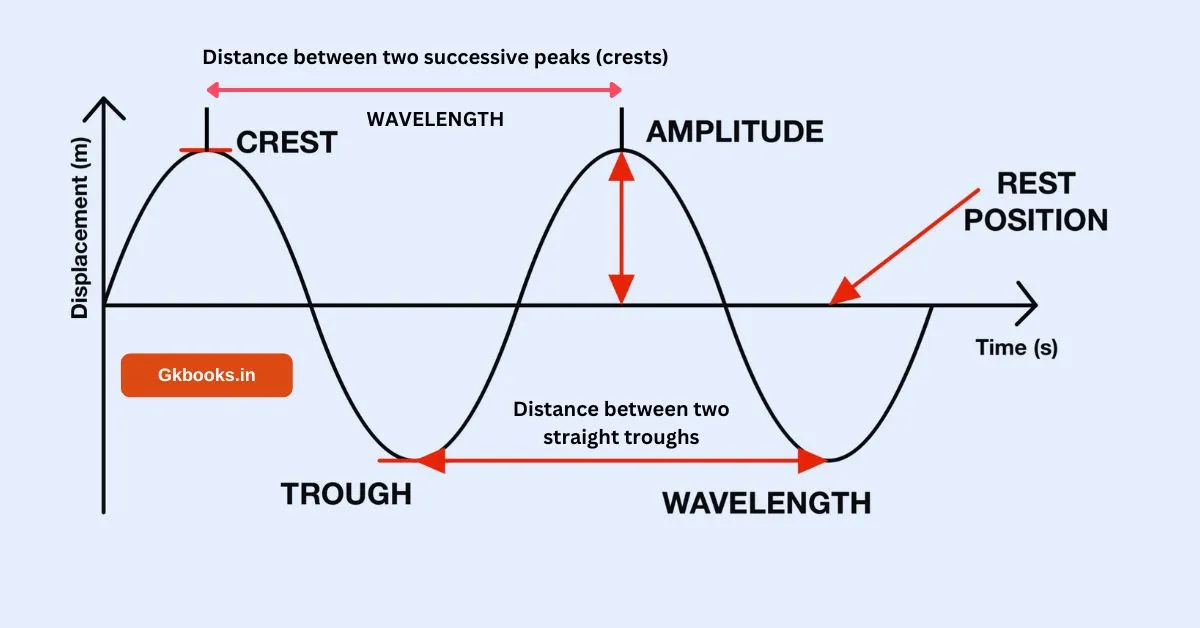
The Inverse Relationship
It’s important to note that wavelength and frequency have an inverse relationship. This means as one increases, the other decreases, and vice versa. This relationship can be expressed by the equation: v = fλ, where:
- v = speed of sound in the medium (relatively constant for a given medium)
- f = frequency of the sound wave (cycles per second – Hertz)
- λ = wavelength of the sound wave (meters)
Since the speed of sound in a medium is relatively constant, a shorter wavelength (faster vibrations) must be accompanied by a higher frequency to maintain this constant speed.
Analogy
Think of wavelength as the space between the keys on a piano. Pressing a white key on the left side (longer key) produces a lower-pitched sound while pressing a white key on the right (shorter key) produces a higher-pitched sound. The distance between the keys (wavelength) is related to the resulting pitch.
Additional Characteristics
Beyond the fundamental properties of frequency, amplitude, and wavelength, sound waves have a couple of additional characteristics that influence our perception:
Timber or Quality of Sound
Timbre and sound quality are two ways to describe the same thing: the characteristic of sound that allows us to distinguish between different sounds even if they have the same pitch and loudness.
Here’s a breakdown of the timbre:
What it is
Timbre is like a sound’s fingerprint. It makes a flute sound different from a violin playing the same note or a human voice distinct from another.
What creates it
Unlike pitch (related to frequency) and loudness (related to amplitude), timbre is determined by the harmonic content of the sound wave.
Most sounds we hear are not pure tones with a single frequency but rather complex waveforms comprising a fundamental frequency and a series of higher frequencies called harmonics. The specific combination, strength, and presence of these harmonics create the unique timbre of a sound.
Analogy
Imagine sound waves like light waves. Pure white light consists of all the colors of the rainbow combined. When white light passes through a prism, it separates into individual colors because each color has a slightly different wavelength. Similarly, the complex sound wave from an instrument can be considered a combination of pure tones (frequencies) at various strengths. How these “sound colors” are mixed determines the overall timbre.
✅ Timber or Quality of Sound Key Points
🔹 It is a characteristic of the Sound wave by which we can differentiate two sounds having the Same Pitch and Loudness.
🔹 The Quality of timber depends on the Waveform of the sound wave.
🔹 The more pleasant sound is said to be of rich quality.
🔹 A Single frequency (single cycle) sound is called a Tone.
🔹 A sound produced due to a combination of several tones is called a Note.
🔹 Noise is unpleasant to the ear while music is pleasant to the ear.
🔹 Music and Noise are both closely related to the waveform produced by any musical instrument.
Music and Noise, are both subjective quantities.
☛ The musical sound waveform is Regular, Smooth, Continuous, and Periodic.
☛ Whereas the noise waveform is irregular, harsh, discontinuous, and non-periodic.
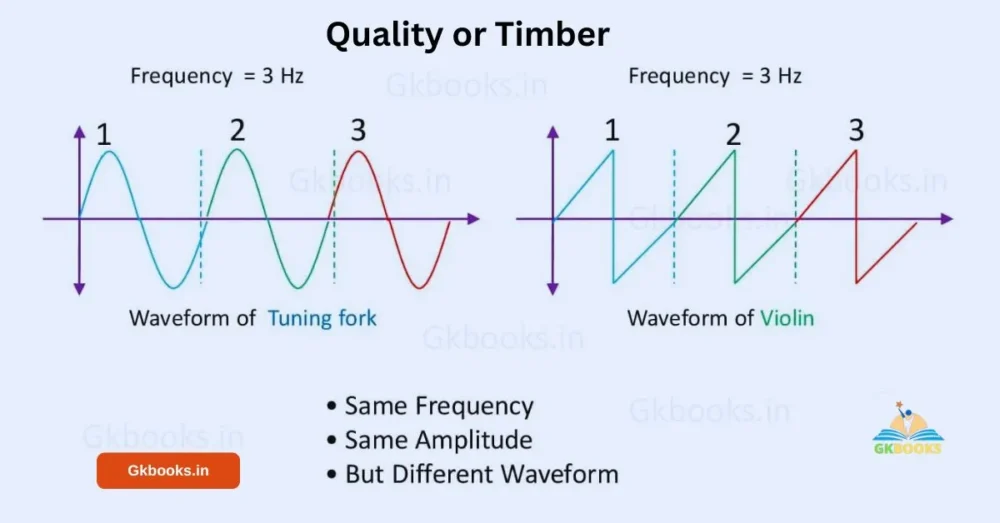
Speed
The speed of sound tells us how fast sound waves travel through a particular medium. Here’s a deeper dive into this concept:
What it is
The speed of sound refers to the rate at which sound waves propagate through a medium, such as air, water, or solids. It’s measured in meters per second (m/s) or per hour (km/h).
What affects it
Unlike the characteristics of the sound wave (frequency, amplitude, wavelength), the speed of sound is primarily determined by the properties of the medium it travels through. Here are some key factors:
Density
Generally, sound travels faster in denser mediums. For example, sound travels much faster through steel (a dense solid) than air (a less dense gas). Denser materials have particles closer together, allowing for a more efficient transfer of vibrations.
Temperature
In a given medium, the speed of sound typically increases with temperature. As the temperature rises, the particles in the medium vibrate with more energy, facilitating faster transfer of sound waves.
Medium composition
The specific composition of the medium can also play a role. For instance, the speed of sound in different types of solids can vary depending on their material properties.
Examples
- The speed of sound in air at room temperature (20°C) is approximately 343 meters per second (m/s) or 1,125 feet per second (ft/s).
- The speed of sound in water is 1,484 meters per second (m/s) or 4,867 feet per second (ft/s), roughly four times faster than in air.
- The speed of sound in steel is significantly faster than in air or water, reaching around 5,100 meters per second (m/s) or 16,733 feet per second (ft/s).
Importance
Understanding the speed of sound has various applications in science, engineering, and everyday life. Here are a few examples:
- Locating sound sources: By measuring the time difference between seeing a lightning flash and hearing the thunder, we can estimate the distance to the lightning strike using the speed of sound in the air.
- Medical imaging: The speed of sound is crucial in medical ultrasound imaging, where sound waves are used to create images of internal organs.
- Aerodynamics: In aeronautics, the speed of sound is critical for understanding sonic booms produced by supersonic aircraft.
Understanding the speed of sound and how it interacts with different mediums gives us a deeper appreciation of how sound propagates in our world.
Difference between Intensity and Loudness
| Characteristic | Intensity | Loudness |
|---|---|---|
| Definition | The amount of energy transmitted per unit area by a sound wave, typically measured in watts per square meter (W/m²). | The subjective perception of the strength or volume of a sound, influenced by the amplitude of the sound wave. |
| Objective/Subjective | Objective – It can be measured directly with instruments and quantified with numerical values. | Subjective – It varies from person to person and depends on individual auditory perception. |
| Measurement | Typically measured in watts per square meter (W/m²) or decibels (dB), using sound level meters or similar devices. | Not directly measurable but can be inferred from intensity measurements and psychoacoustic principles. |
| Influence | Determined by the amount of energy carried by the sound wave, affected by factors such as distance from the source and medium properties. | Influenced by the amplitude and frequency of the sound wave, as well as psychoacoustic factors such as masking and auditory adaptation. |
| Standardization | Can be standardized and measured consistently using calibrated instruments. | Difficult to standardize due to its subjective nature, although standardized psychoacoustic models exist for approximating loudness. |
| Applications | Important in fields such as physics, engineering, and environmental noise assessment. | Relevant in fields such as psychology, audio engineering, and product design, particularly in areas where human perception of sound quality is crucial. |
Difference between Objective and Subjective Quantity
| Characteristic | Objective Quantity | Subjective Quantity |
|---|---|---|
| Definition | Quantities that have a definite value and are identical for every person. | Quantities that vary from person to person based on individual perception. |
| Example | Decibel (dB), intensity of sound (e.g., 100 dB, 5 watt/m²) | Loudness (e.g., 100 dB) |
| Measurement | Measured directly with instruments, expressed with numerical values and units. | Depends on individual perception and cannot be measured directly. |
| Consistency | Consistent across different observers or measurements. | Varies among individuals, influenced by factors such as physiology and psychology. |
| Application | Widely used in scientific, engineering, and quantitative contexts where standardization is necessary. | Important in fields such as psychology, music, and design, where individual experience and perception are key. |
| Examples of Use | Physics, engineering, environmental noise assessment. | Audio engineering, psychology, aesthetics. |
Difference between – Amplitude, Pitch, and Waveform
Here’s a comparison between amplitude, pitch, and waveform presented in a tabular format:
| Characteristic | Amplitude | Pitch | Waveform |
|---|---|---|---|
| Definition | The magnitude or strength of a sound wave, which determines its loudness. | The perceived frequency of a sound wave, determining its highness or lowness. | The visual representation of a sound wave’s variation in air pressure over time. |
| Measurement | Typically measured in decibels (dB). | Measured in Hertz (Hz). | N/A (Represents the shape of the wave graphically). |
| Perception | Determines how loud or soft a sound is perceived. | Determines how high or low a sound is perceived. | Represents the pattern of oscillations in the air pressure over time. |
| Influence | Higher amplitudes result in louder sounds. | Higher pitch corresponds to higher frequency sounds. | Different waveforms represent various types of sounds (e.g., sine, square, sawtooth). |
| Application | Used to control the volume or loudness of audio signals. | Important in music theory and speech perception. | Used in audio editing and synthesis to manipulate sound characteristics. |
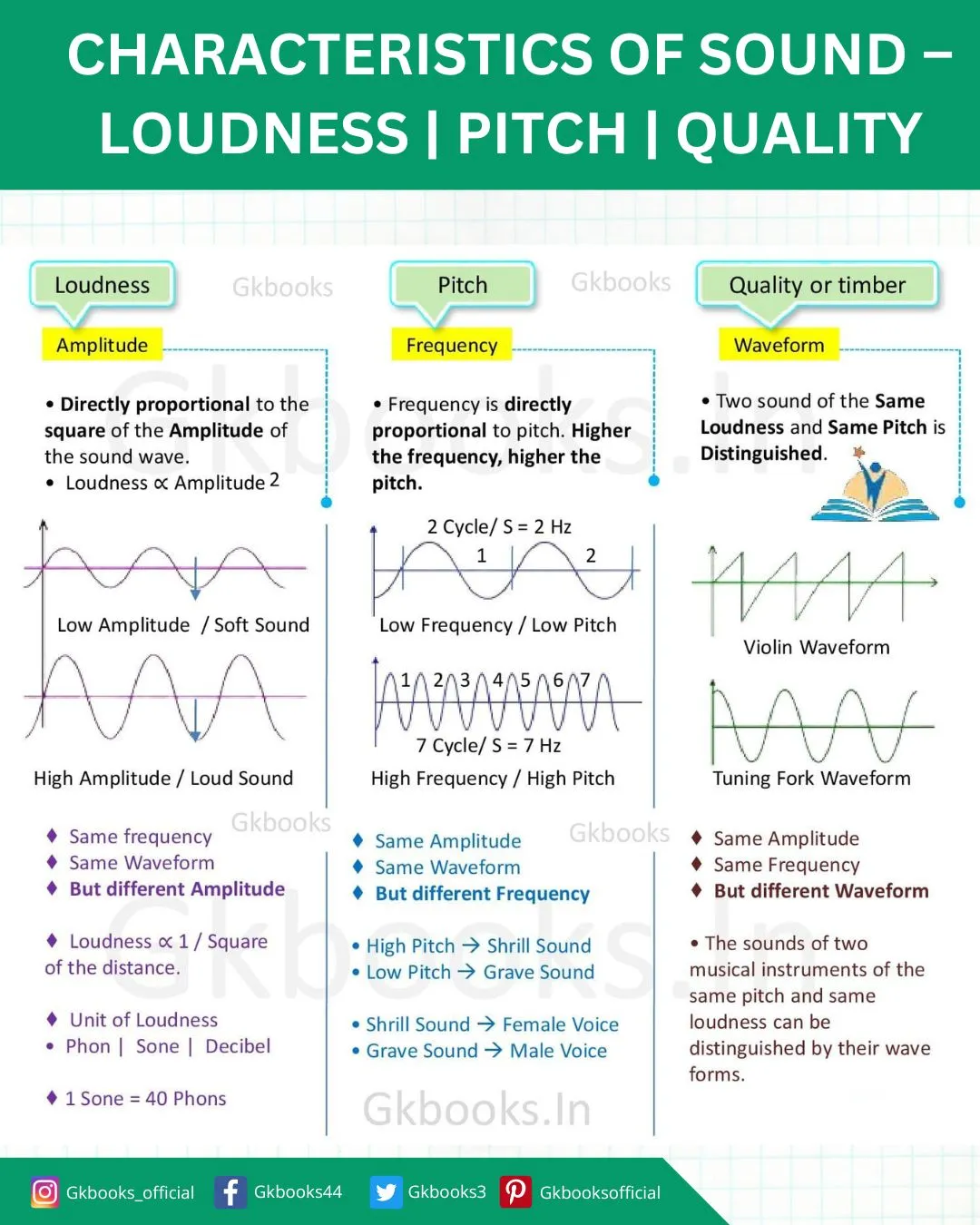
Top One Liner about the Characteristics of sound
What is the SI unit of Frequency?
Answer: Hertz (Hz)
What is the SI unit of Intensity?
Answer: Watt per square meter (W/m²)
What is the term for the amount of energy passing through a unit area?
Answer: Intensity
Is Loudness an objective or subjective quantity?
Answer: Subjective Quantity
How does their sound distinguish two different musical instruments?
Answer: Quality or Timbre
What is the characteristic waveform of Noise?
Answer: Irregular, harsh, and discontinuous
What factor determines the Quality of Timbre?
Answer: Waveform
How is a rich-quality sound described?
Answer: More pleasant
Is Loudness an objective or subjective quantity?
Answer: Subjective Quantity
What term describes the number of waveforms produced per unit of time?
Answer: Frequency
What does a high-pitched sound correspond to?
Answer: High-frequency
How can the voices of males and females be distinguished?
Answer: Pitch
What is the unit of measurement for loudness?
Answer: Decibel (dB)
What is the intensity of the softest sound that can be heard?
Answer: 0 dB
What is the intensity of the softest sound in terms of watts per square meter?
Answer: (10^{-12}) watt per square meter (W/m²)
Which characteristic of sound depends on amplitude?
Answer: Loudness
FAQs on Characteristics of Sound
Answer: The 3 main characteristics of sound are Pitch. Height and quality.
Answer: The loudness is related to Amplitude.
Answer: Two different musical instruments
Answer: Pitch
Answer: Loudness
✅ Source: NCERT Class 9, Chapter 12
Exploring Physics Through Engaging Notes:


